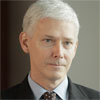Why Won’t Bernanke Come Clean on Glut?
Perhaps the greatest mystery in the world of finance and economics is why Fed Chairman Ben Bernanke refuses to acknowledge that paper money creation by central banks produced the “global savings glut” which, according to him, destabilized the global economy and led to the crisis of 2008.
Six years ago, Bernanke unleashed his Global Savings Glut (GSG) theory on the world. Since then, he has made numerous other speeches touching on this subject, including one last month in Paris. With each speech he came a little closer to admitting the obvious, but in every case he holds back, as if not at liberty to discuss the secret money-making powers of central bankers.
The basic gist of GSG is Asians, and oil exporters, save more than they wish to invest in their own countries and they choose to invest the surplus in the United States because of attractive returns. Those capital inflows into the US, he claims, push up US asset prices and push down US interest rates, leading to asset-price bubbles and the US current account deficit.
The GSG theory would be accurate if only he would add that most of the “savings” causing the “glut” originate because central banks created and “saved” the equivalent of many trillions of dollars over the past 15 years.
The theory comes across as rather absurd when that fact is omitted. As it stands, the GSG theory clashes with reality in two important respects. First, US financial markets may be deep, but they are certainly not well regulated. Second, Asians do not believe US investments offer attractive returns.
In June 2009, Treasury Secretary Tim Geithner was laughed at by an audience of Chinese students after insisting that China’s US assets are safe. Asians believe the United States and its dollar are in terminal decline and the future belongs to Asia.
But the theory does make sense when it is modified to recognize that Asian “savers” investing in US assets are Asian central banks that bought US dollars in order to hold down the value of their own currencies perpetuating their low-wage trade advantage; and that those central banks must invest those dollars in US dollar-denominated assets to earn a return.
A few times over the years, Bernanke has come close to clarifying this. In the 2005 speech, he said “some East Asian countries, such as Korea and Thailand began to build up large quantities of foreign-exchange reserves” and “China also built up reserves.”
“These ‘war chests’ of foreign reserves have been used as a buffer against potential capital outflows,” he said. “Additionally, reserves were accumulated in the context of foreign exchange interventions intended to promote export-led growth by preventing exchange-rate appreciation.”
He made similar remarks last November, admitting the international monetary system (the dollar standard) “has a structural flaw: It lacks a mechanism, market based or otherwise, to induce needed adjustments by surplus countries, which can result in persistent imbalances.”
But he never explains how countries accumulate foreign exchange reserves. Foreign exchange is accumulated when a country’s central bank prints money and buys the foreign exchange.
Over the past decade total foreign exchange reserves held by central banks have increased by more than $7 trillion to $9.3 trillion. This involved paper money creation on a scale unprecedented during peacetime. To put this figure in perspective, the entire US federal government debt held by the public amounted to less than $5 trillion in 2007.
Practically all of this paper money creation was carried out by central banks in developing countries. China’s central bank alone holds nearly $3 trillion worth of foreign exchange reserves, a third of the total. China, by the way, has capital controls, so has no need to build up a “war chest” as “a buffer against potential capital outflows.” The acquisition of these reserves has been an act of currency manipulation, pure and simple.
Why has Bernanke never mentioned that the accumulation of foreign exchange reserves involves paper money creation by central banks? He may not know. Or he may not want the public to know. It’s difficult to say which is more disturbing.
But in reality, he must know. How could he have missed the explosive growth of central bank balance sheets in China and many other developing countries? But why would he want to hide from the public the creation of trillions of dollars worth of paper money when it has played the driving role in destabilizing the global economy?
This is the mystery.
What’s clear is that the equivalent of trillions of dollars was created by central banks in the decade leading up to the global economic crisis, that money played a leading role in causing the crisis, that central banks have created trillions more since the crisis began, that global food prices spiked, causing revolution across the Arab world and that central bankers are doing everything possible to avoid accepting responsibility for the havoc.
There is no mystery about the causes of inflation. As Milton Friedman put it, “Inflation is always and everywhere a monetary phenomenon.”
Regards,
Richard Duncan
for The Daily Reckoning
P.S. This article was first posted on a guest blog at cnbc.com on March 7, 2011. For more perspective on economics in the age of paper money you can visit my blog at www.richardduncaneconomics.com.


Comments: